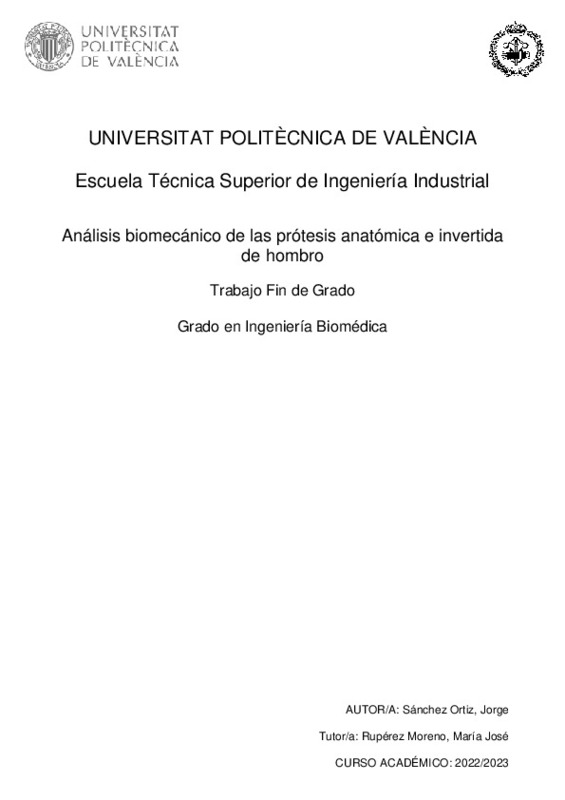|
Resumen:
|
[ES] Este trabajo tiene como propósito el diseño y estudio de las principales prótesis de hombro, siendo estas la anatómica y la invertida. El análisis a realizar va a ser durante el proceso de abducción del brazo y se ...[+]
[ES] Este trabajo tiene como propósito el diseño y estudio de las principales prótesis de hombro, siendo estas la anatómica y la invertida. El análisis a realizar va a ser durante el proceso de abducción del brazo y se estudiará como varía el comportamiento prostético en diferentes grados de dicho movimiento. Además, se observarán las diferencias presentadas por ambos modelos para poder determinar el más adecuado ante las condiciones establecidas.
Para conseguir este objetivo ha sido necesario el modelado de las dos prótesis, ambas de carácter modular y dimensiones similares, mediante el uso de programas CAD. Tras el modelado se han introducido los diseños en un programa CAE y se han aplicado condiciones de contorno, los materiales de los que estarían fabricados las distintas piezas prostéticas y las fuerzas que serían anatómicamente ejercidas durante el movimiento de abducción humeral, para tener un análisis biomecánico lo más realista posible. Una vez implementado el modelo y aplicadas las condiciones se estudia el desarrollo de las tensiones presentes en el volumen, observando gracias al uso del método de elementos finitos (MEF), la deformación de las prótesis durante el desplazamiento del brazo y las regiones de mayor riesgo a rotura.
En los resultados obtenidos para ambos modelos, no se observa riesgo de fractura o deformación excesiva de manera puntual, aunque sí que se puede observar que, en grados de abducción próximos a la horizontalidad del brazo, los valores son más acentuados, implicando riesgos en el uso prolongado de las mismas prótesis debido a la aparición de desgaste.
De este estudio se concluye que las prótesis anatómica e invertida diseñadas podrían ser funcionales debido a su baja relación tensión máxima-límite elástico además de que la elección del diseño aplicado dependerá de las condiciones de movilidad y edad del paciente, siendo necesario un balance y un estudio de riesgos y beneficios.
[-]
[EN] The purpose of this work is to design and study the main shoulder prostheses, the anatomical and the inverted. The analysis will be carried out during the process of abduction of the arm and it will be studied how the ...[+]
[EN] The purpose of this work is to design and study the main shoulder prostheses, the anatomical and the inverted. The analysis will be carried out during the process of abduction of the arm and it will be studied how the prosthetic behaviour varies in different degrees of this movement. In addition, the differences presented by both models will be observed in order to determine the most suitable one for the established conditions.
This required modelling the two prostheses, both of which are modular and of similar dimensions, using CAD programmes. After modelling, the designs were introduced into a CAE programme and boundary conditions were applied, the materials from which the different prosthetic pieces would be made and the forces that would be anatomically exerted during the humeral abduction movement in order to have the most realistic biomechanical analysis possible. Once the model has been implemented and the conditions have been applied, the development of the stresses present in the volume is studied, observing, thanks to the use of the finite element method (FEM), the deformation of the prostheses during the displacement of the arm and ) the regions of greatest risk of breakage.
In the results obtained for both models, no risk of fracture or excessive deformation is observed at specific points, although it can be observed that, in degrees of abduction close to the horizontality of the arm, the values are more accentuated, implying risks in the prolonged use of the prostheses themselves due to the appearance of wear and tear.
From this study we conclude that the anatomical and inverted prostheses designed could be functional due to their low maximum stress-elastic limit ratio, in addition to the fact that the choice of the design applied will depend on the mobility conditions and age of the patient, a balance and a study of risks and benefits being necessary.
[-]
|







